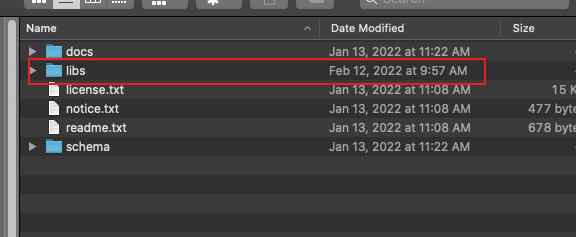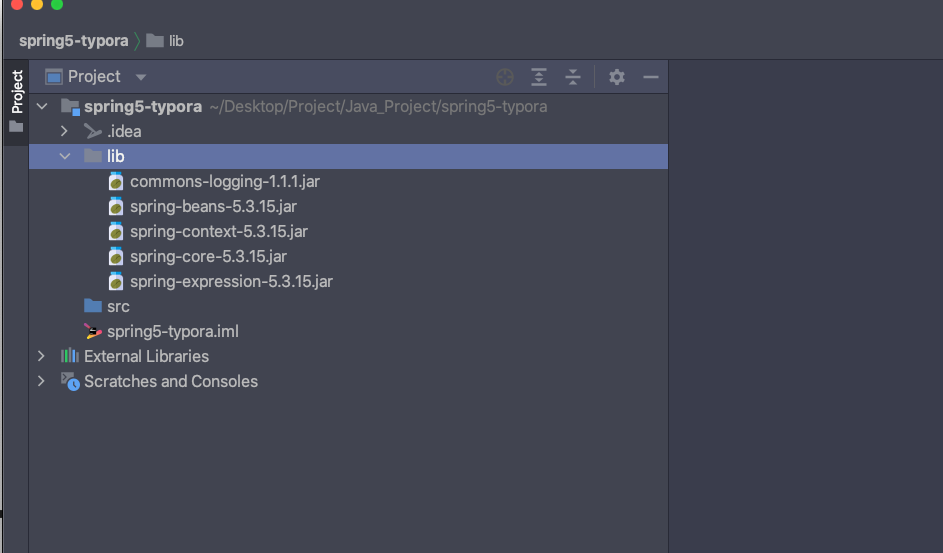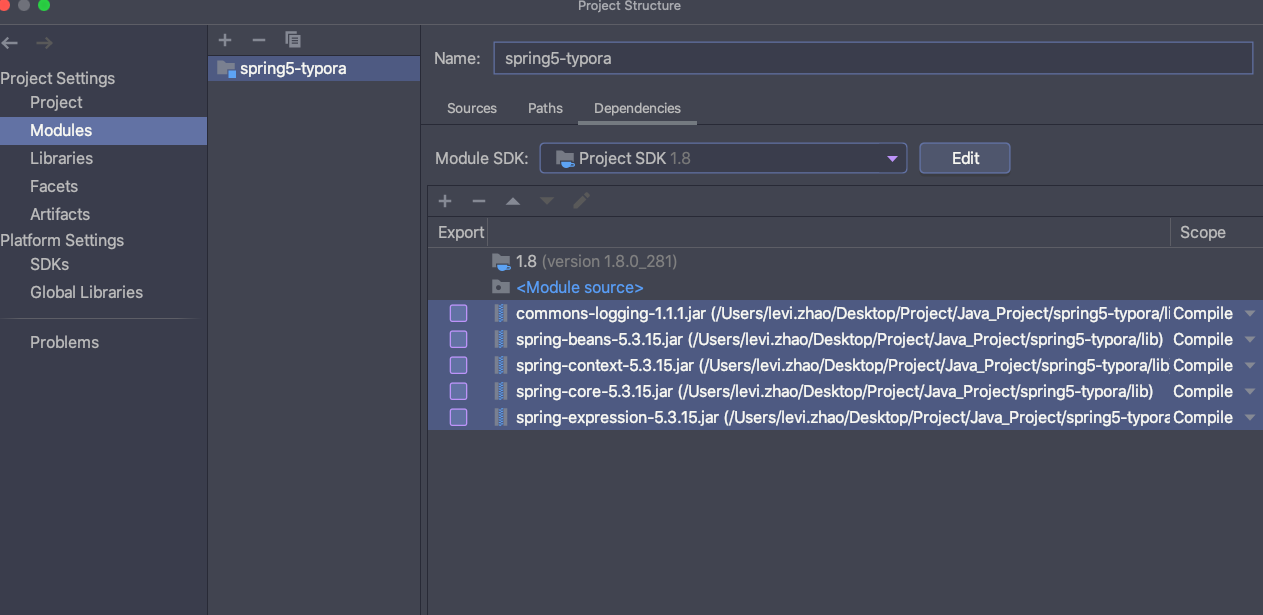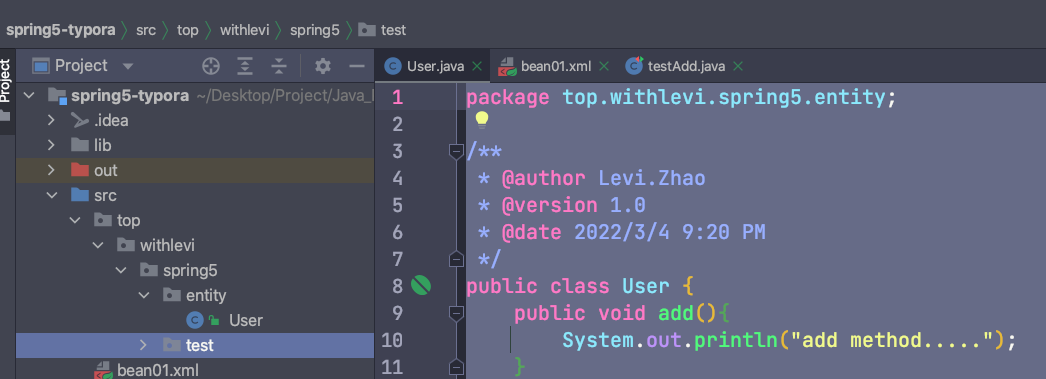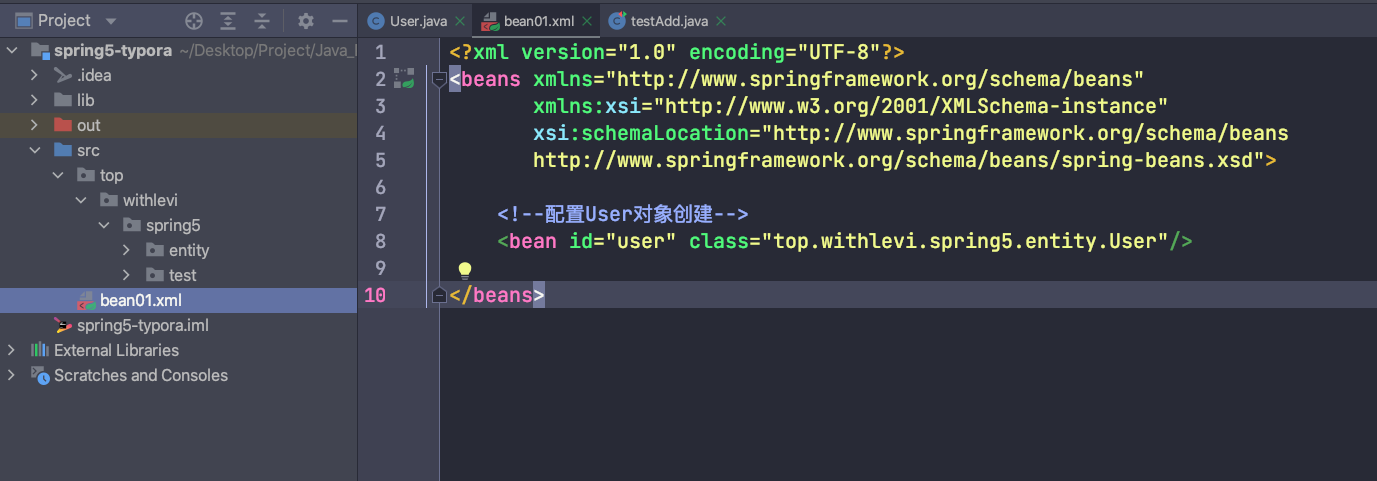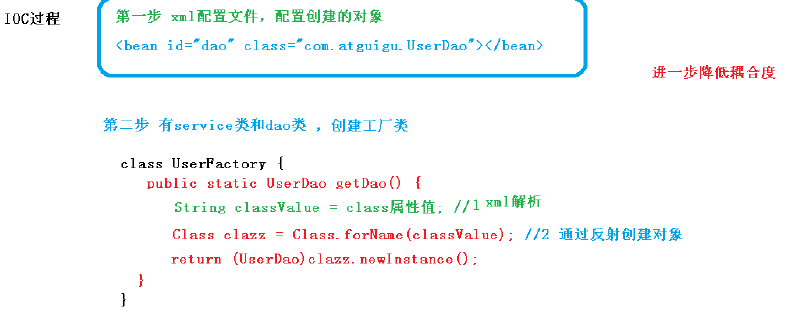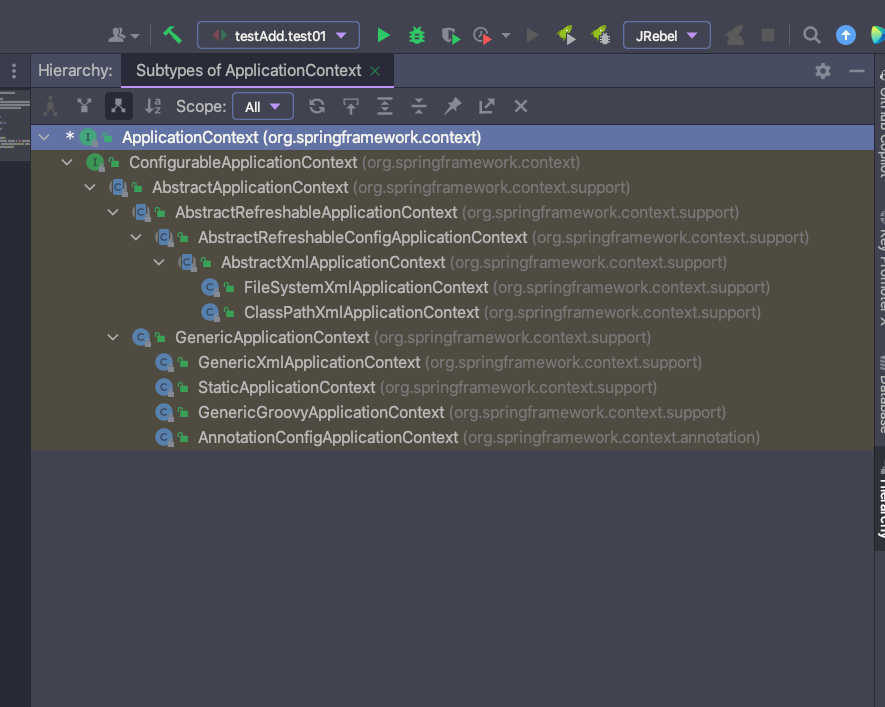Spring5框架
一、内容介绍
- Spring 框架概述
- IOC容器
- IOC底层原理
- IOC接口(BeanFactory)
- IOC操作Bean管理(基于xml)
- IOC操作管理(基于注解)
- AOP
- JdbcTemplate
- 事务管理
- Spring5新特性
二、Spring5框架概述
- Spring是轻量级的开源的Java框架
- Spring可以解决企业应用开发的复杂性
- Spring有两个核心部分: IOC和AOP
- IOC:控制反转,把创建对象过程交给Spring进行管理
- AOP:面向切面,不修改源代码进行功能增强
- Spring特点
- 方便解耦,简化开发
- AOP编程支持
- 方便程序测试
- 方便和其他框架进行整合
- 方便进行事务管理
- 降低API开发难度
- Spring5框架下载 下载地址
三、Spring5入门案例
1、在spring官网下载最新稳定版
2、下载之后解压在libs目录
3、使用IntellJ IDEA 创建一个JAVA工程
3.1、创建一个java工程
3.2、工程界面
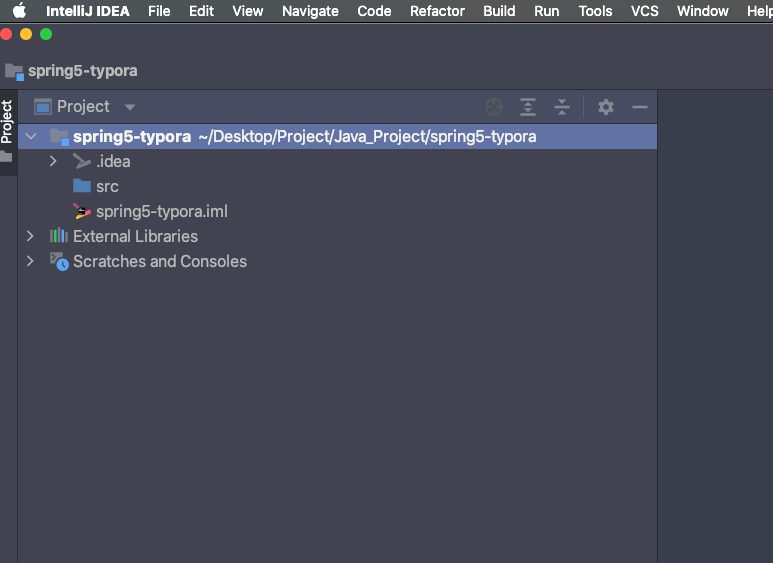
3.3、导入需要用的Jar包
4、创建entity包并创建普通类User
5、创建Spring配置文件, 在配置文件配置创建的对象-bean01.xml
6、进行测试代码编写
1
2
3
4
5
6
# 输出结果
top.withlevi.spring5.entity.User@cb0ed20
add method.....
Process finished with exit code 0
四、IOC(概念和原理)
- 什么是IOC
- 控制反转,把对象创建和对象之间的调用过程,交给Spring进行管理
- 使用IOC目的: 为了耦合度降低
- IOC底层原理
- XML解析、工厂模式、反射
- IOC底层原理
-
IOC(BeanFactory接口)
-
IOC思想基于IOC容器完成,IOC容器底层就是对象工厂
-
Spring提供IOC容器实现两种方式:(两个接口)
-
BeanFactory:IOC容器基本实现,是Spring内部的使用接口,不提供开发人员进行使用
*加载配置文件时候不会创建对象,在获取对象使用才去创建对象
-
ApplicationContext:BeanFactory接口的子接口,提供更多更强大的功能,一般由开发人员进行使用
*加载配置文件时候就会把在配置文件对象进行创建
-
ApplicationContext接口有实现类(Ctrl+H 显示类的继承关系
-
-
5、IOC操作Bean管理(概念)
5.1、什么是Bean管理
- Bean管理指的是两个操作
- Spring创建对象
- Spring注入对象
5.2、 Bean管理操作有两种方式
- 基于xml配置文件方式实现
- 基于注解方式实现
6、IOC操作Bean管理(基于xml方式)
6.1、基于xml方式创建对象
- 在spring配置文件中,使用bean标签,标签里面添加对应属性,就可以实现对象创建
- 在bean标签有很多属性,介绍常用的属性
- id属性:唯一标识
- class属性:类全路径(包类路径)
- 创建对象时候,默认也是执行五参数构造方法完成对象创建
6.2、基于xml方式注入属性
- DI: 依赖注入,就是注入属性
6.3、第一种注入方式:使用set方法进行注入
- 创建类,定义属性和对象的set方法
- 在spring配置文件配置对象创建,配置属性注入
6.4、第二种注入方式: 使用有参构造进行注入
创造类,定义属性,创建属性对应有参构造方法
在Spring配置文件中进行配置
6.5、p名称空间注入(了解)
使用p空间注入、可以简化基于xml配置方式
第一步添加p空间在配置文件中并进行属性注入、在bean标签里面进行操作
7、IOC操作Bean管理(xml注入其他类型属性)
7.1、字面量
null值
属性值包含特殊符号
7.2、注入属性-外部bean
创建两个类service类和Dao类
在service调用dao里面的方法
在spring配置文件中进行配置
```java // 创建UserDaoImpl实现类 package top.withlevi.spring5.dao.impl; import top.withlevi.spring5.dao.UserDao; /** * @author Levi.Zhao * @version 1.0 * @date 2022/3/6 9:36 PM */ public class UserDaoImpl implements UserDao { @Override public void update() { System.out.println("This is update method...."); } } ```java ```java // 创建UserService类 package top.withlevi.spring5.service; import top.withlevi.spring5.dao.UserDao; /** * @author Levi.Zhao * @version 1.0 * @date 2022/3/6 9:38 PM */ public class UserService { //创建UserDao类型属性 生成set方法 private UserDao userDao; public void setUserDao(UserDao userDao) { this.userDao = userDao; } public void add(){ System.out.println("service add......"); userDao.update(); } }
# 输出结果 top.withlevi.spring5.service.UserService@954b04f service add...... This is update method....
7.3、注入属性-内部bean
一对多关系: 部门和员工
一个部门有多个员工,一个员工属于一个部门
部门是一,员工是多
在实体类之间表示一对多关系,员工表示所属部门,使用对象类型属性进行表示
8、IOC操作Bean管理(xml注入集合属性)
8.1、注入数组类型属性
8.2、注入List集合类型属性
8.3、注入Map集合类型属性
-
创建类,定于数组,list,map,set类型属性,生成对应set方法
1 2 3 4 5 6 7 8 9 10 11 12 13 14 15 16 17 18 19 20 21 22 23 24 25 26 27 28 29 30 31 32 33 34 35 36 37 38 39 40 41 42 43 44 45 46 47 48 49 50
package top.withlevi.spring5.bean; import java.util.Arrays; import java.util.List; import java.util.Map; import java.util.Set; /** * Created by Levi Zhao on 3/29/2022 3:54 PM * * @Author Levi */ public class Stu { // 1. 数组类型属性 private String[] courses; // 2. list集合类型 private List<String> list; // 3. map集合类型 private Map<String, String> maps; // 4. set集合类型 private Set<String> sets; public void setCourses(String[] courses) { this.courses = courses; } public void setList(List<String> list) { this.list = list; } public void setMaps(Map<String, String> maps) { this.maps = maps; } public void setSets(Set<String> sets) { this.sets = sets; } @Override public String toString() { return "Stu{" + "courses=" + Arrays.toString(courses) + ", list=" + list + ", maps=" + maps + ", sets=" + sets + '}'; } }
-
在spring配置文件进行配置
1 2 3 4 5 6 7 8 9 10 11 12 13 14 15 16 17 18 19 20 21 22 23 24 25 26 27 28 29 30 31 32 33 34 35 36 37 38 39 40 41 42
<?xml version="1.0" encoding="UTF-8"?> <beans xmlns="http://www.springframework.org/schema/beans" xmlns:xsi="http://www.w3.org/2001/XMLSchema-instance" xsi:schemaLocation="http://www.springframework.org/schema/beans http://www.springframework.org/schema/beans/spring-beans.xsd"> <!--1.集合类型熟悉注入--> <bean id="stu" class="top.withlevi.spring5.bean.Stu"> <!--数组类型属性注入--> <property name="courses"> <array> <value>Java课程</value> <value>数据库课程</value> </array> </property> <!--list类型属性注入--> <property name="list"> <list> <value>张三</value> <value>李四</value> </list> </property> <!--map类型属性注入--> <property name="maps"> <map> <entry key="Java" value="java"></entry> <entry key="PHP" value="php"></entry> </map> </property> <!--set类型属性注入--> <property name="sets"> <set> <value>MYSQL</value> <value>Redis</value> </set> </property> </bean> </beans>
8.4、在集合里面设置对象类值
-
配置bean.xml
1 2 3 4 5 6 7 8 9 10 11 12 13 14 15 16 17 18 19 20 21 22
<?xml version="1.0" encoding="UTF-8"?> <beans xmlns="http://www.springframework.org/schema/beans" xmlns:xsi="http://www.w3.org/2001/XMLSchema-instance" xsi:schemaLocation="http://www.springframework.org/schema/beans http://www.springframework.org/schema/beans/spring-beans.xsd"> <!--创建多个course对象--> <bean id="course1" class="top.withlevi.spring5.bean.Course"> <property name="cname" value="Spring5框架"></property> </bean> <bean id="course2" class="top.withlevi.spring5.bean.Course"> <property name="cname" value="MyBatis框架"></property> </bean> <bean id="stu2" class="top.withlevi.spring5.bean.Stu"> <property name="courseList"> <list> <ref bean="course1"/> <ref bean="course2"/> </list> </property> </bean> </beans>
-
Course 类
1 2 3 4 5 6 7 8 9 10 11 12 13 14 15 16
package top.withlevi.spring5.bean; public class Course { private String cname; public void setCname(String cname) { this.cname = cname; } @Override public String toString() { return "Course{" + "cname='" + cname + '\'' + '}'; } }
8.5、把集合注入部分提取出来
-
在spring配置文件中引入名称空间util
1 2 3 4 5 6 7 8 9 10 11 12 13 14 15 16 17 18 19 20 21 22 23
<?xml version="1.0" encoding="UTF-8"?> <beans xmlns="http://www.springframework.org/schema/beans" xmlns:xsi="http://www.w3.org/2001/XMLSchema-instance" xmlns:p="http://www.springframework.org/schema/p" xmlns:util="http://www.springframework.org/schema/util" xsi:schemaLocation="http://www.springframework.org/schema/beans http://www.springframework.org/schema/beans/spring-beans.xsd http://www.springframework.org/schema/util http://www.springframework.org/schema/util/spring-util.xsd"> <!--提取list集合类型属性注入--> <util:list id="bookList"> <value>Java</value> <value>Vue</value> <value>Python</value> </util:list> <!--提取list集合类型属性注入使用--> <bean id="book" class="top.withlevi.spring5.bean.Book"> <property name="list" ref="bookList"/> </bean> </beans>
-
创建Book类
1 2 3 4 5 6 7 8 9 10 11 12 13 14 15 16 17 18
package top.withlevi.spring5.bean; import java.util.List; public class Book { private List<String> list; public void setList(List<String> list) { this.list = list; } @Override public String toString() { return "Book{" + "list=" + list + '}'; } }
9、IOC操作Bean管理(FactoryBean)
9.1、Spring两种类型bean
-
普通bean:在配置文件中定义bean类型就是返回类型
-
工厂bean:在配置文件定义bean类型可以和返回类型不一样
第一步 创建类, 让这个类作为工程bean, 实现接口FactoryBean
第二步 实现接口里面的方法, 在实现的方法中定义返回的bean类型
1
2
3
4
5
6
7
8
9
10
11
12
13
14
15
16
17
18
19
20
21
22
23
24
25
package top.withlevi.spring5.factory;
import org.springframework.beans.factory.FactoryBean;
import top.withlevi.spring5.bean.Course;
public class MyBean implements FactoryBean<Course> {
// 定义返回bean
@Override
public Course getObject() throws Exception {
Course course = new Course();
course.setCname("Hello Spring5");
return course;
}
@Override
public Class<?> getObjectType() {
return null;
}
@Override
public boolean isSingleton() {
return FactoryBean.super.isSingleton();
}
}
1
<bean id="myBean" class="top.withlevi.spring5.factory.MyBean"/>
1
2
3
4
5
6
7
@Test
public void testFactoryBean() {
ApplicationContext context = new ClassPathXmlApplicationContext("bean05.xml");
Course myBean = context.getBean("myBean", Course.class);
System.out.println(myBean);
}
9.2、IOC操作管理(bean作用域)
-
在Spring里面,设置创建bean实例是单实例还是多实例
-
在Spring里面,默认情况下,bean是单实例对象
1 2 3 4 5 6 7 8 9
@Test public void testFactoryBean2() { ApplicationContext context = new ClassPathXmlApplicationContext("bean05.xml"); Book book1 = context.getBean("book2", Book.class); Book book2 = context.getBean("book2", Book.class); System.out.println(book1); System.out.println(book2); }
输出结果:
1 2 3
// 输出结果相同 top.withlevi.spring5.bean.Book@4b53f538 top.withlevi.spring5.bean.Book@4b53f538
-
如何设置单实例还是多实例
- 在spring配置文件bean标签里面有属性(scope) 用于设置单实例还是多实例
- scope属性值
- 第一个值 默认值,singleton,表示是单实例对象
- 第二个值 prototype,表示是多实例对象
1 2 3 4 5 6 7 8
<bean id="book2" class="top.withlevi.spring5.bean.Book" scope="prototype"> <property name="list"> <list> <value>Hello Spring5</value> <value>Hello SpringMVC</value> </list> </property> </bean>
输出结果:
1 2 3
// 输出结果不同 top.withlevi.spring5.bean.Book@134593bf top.withlevi.spring5.bean.Book@4bb4de6a
-
singleton和prototype区别
-
第一singleton单实例,prototype多实例
-
设置scope值是singleton时候,加载spring配置文件时候就会创建单实例对象
设置scope值是prototype时候,不是在加载spring配置文件时候创建对象,在调用
getBean方法的时候创建多实例对象
-
9.3、IOC操作Bean管理(bean生命周期)
-
生命周期
- 从对象创建等到对象销毁的过程
-
bean生命周期
- 通过构造器创建bean实例(无参数构造方法)
- 为bean的属性设置值和对其他bean引用(调用set方法)
- 调用bean的初始化的方法(需要进行设置初始化的方法)
- bean可以使用了(对象获取到了)
- 当容器关闭时候,调用bean的销毁的方法(需要进行配置销毁的方法)
-
演示bean生命周期
1 2 3 4 5 6 7 8 9 10 11 12 13 14 15 16 17 18 19 20 21 22 23 24 25 26 27 28 29 30 31 32 33 34 35 36 37 38 39 40 41 42
package top.withlevi.spring5.bean; public class Orders { private String oname; private String address; public Orders() { System.out.println("First step - Execute a no-argument construct and create bean instance."); } public Orders(String oname, String address) { this.oname = oname; this.address = address; } public void setOname(String oname) { this.oname = oname; System.out.println("Second - Invoke method and set properties value"); } public void setAddress(String address) { this.address = address; } public void initMethod(){ System.out.println("Third - Execute initialize method"); } public void destroyMethod(){ System.out.println("fifth - Execute destroy method"); } @Override public String toString() { return "Orders{" + "oname='" + oname + '\'' + ", address='" + address + '\'' + '}'; } }
1 2 3 4
<bean id="orders" class="top.withlevi.spring5.bean.Orders" init-method="initMethod" destroy-method="destroyMethod"> <property name="oname" value="iPhone"/> <property name="address" value="Beijing"/> </bean>
1 2 3 4 5 6 7 8 9
@Test public void test03() { ClassPathXmlApplicationContext context = new ClassPathXmlApplicationContext("bean05.xml"); Orders orders = context.getBean("orders", Orders.class); System.out.println("Fourth - Get bean instance of creation"); System.out.println(orders); // 手动让bean实例销毁 context.close(); }
输出结果:
1 2 3 4 5 6
First step - Execute a no-argument construct and create bean instance. Second - Invoke method and set properties value Third - Execute initialize method Fourth - Get bean instance of creation Orders{oname='iPhone', address='Beijing'} fifth - Execute destroy method
-
bean的后置处理器,bean生命周期有七步
- 通过构造器创建bean实例(无参数构造)
- 为bean的属性设置值和对其他bean引用(调用set方法)
- 把bean实例传递bean后置处理器的方法postProcessBeforeInitialization
- 调用bean的初始化的方法(需要进行配置初始化的方法)
- 把bean实例传递bean后置处理器的方法postProcessAfterInitialization
- bean可以使用了(对象获取到了)
- 当容器关闭时候,调用bean的销毁的方法(需要进行配置销毁的方法)
-
演示添加后置处理器效果
创建类,实现接口BeanPostProcessor,创建后置处理器
1 2 3 4 5 6 7 8 9 10 11 12 13 14 15 16 17 18 19
package top.withlevi.spring5.bean; import org.springframework.beans.BeansException; import org.springframework.beans.factory.config.BeanPostProcessor public class MyBeanPost implements BeanPostProcessor { @Override public Object postProcessBeforeInitialization(Object bean, String beanName) throws BeansException { System.out.println("Method execute before initialization "); return bean; } @Override public Object postProcessAfterInitialization(Object bean, String beanName) throws BeansException { System.out.println("Method execute after initialization "); return bean; } }
1 2
<!--Configure after processor --> <bean id="myBeanPost" class="top.withlevi.spring5.bean.MyBeanPost"/>
输出结果:
1 2 3 4 5 6 7 8
First step - Execute a no-argument construct and create bean instance. Second - Invoke method and set properties value Method execute before initialization Third - Execute initialize method Method execute after initialization Fourth - Get bean instance of creation Orders{oname='iPhone', address='Beijing'} fifth - Execute destroy method
10、IOC操作Bean管理(xml自动装配)
10.1、什么是自动装配
- 根据指定装配规则(属性名称或者属性类型),Spring自动将匹配的属性值进行注入
10.2、演示自动装配过程
-
根据属性名称自动注入
实现自动装配
bean标签属性autowire,配置自动装配
autowire属性常用两个值:
byName 根据属性名称注入,注入值bean的id值和类属性名称一样
byType根据属性类型注入
Dept.java
1 2 3 4 5 6 7 8 9 10 11 12 13 14 15 16 17 18 19 20 21 22 23
package top.withlevi.spring5.bean; public class Dept { private String dname; public Dept() { } public String getDname() { return dname; } public void setDname(String dname) { this.dname = dname; } @Override public String toString() { return "Dept{" + "dname='" + dname + '\'' + '}'; } }
Emp.java
1 2 3 4 5 6 7 8 9 10 11 12 13 14 15 16 17 18 19 20 21 22 23 24 25 26 27 28 29 30 31
package top.withlevi.spring5.bean; public class Emp { private String name; private Integer age; private Dept dept; public Emp() { } public void setName(String name) { this.name = name; } public void setAge(Integer age) { this.age = age; } public void setDept(Dept dept) { this.dept = dept; } @Override public String toString() { return "Emp{" + "name='" + name + '\'' + ", age=" + age + ", dept=" + dept + '}'; } }
Byname
```xml <?xml version=”1.0” encoding=”UTF-8”?>
1
2
3
4
5
6
7
8
9
10
11
12
13
14
15
16
17
18
19
20
21
22
byType
```xml
<?xml version="1.0" encoding="UTF-8"?>
<beans xmlns="http://www.springframework.org/schema/beans"
xmlns:xsi="http://www.w3.org/2001/XMLSchema-instance"
xsi:schemaLocation="http://www.springframework.org/schema/beans
http://www.springframework.org/schema/beans/spring-beans.xsd">
<bean id="emp" class="top.withlevi.spring5.bean.Emp" autowire="byType">
<property name="name" value="Levi"/>
<property name="age" value="29"/>
<!--<property name="dept" ref="dept"/>-->
</bean>
<!--注意 要使用byType方式 这个地方只能有一个此类型的创建 否则会报错-->
<bean id="dept" class="top.withlevi.spring5.bean.Dept">
<property name="dname" value="Microsoft Azure"/>
</bean>
</beans>
11、IOC操作Bean管理(外部属性文件)
11.1、直接配置数据库信息
-
配置druid连接池
-
引入druid连接池依赖jar包
druid-1.1.9.jar
直接在bean.xml配置连接池
1
2
3
4
5
6
7
8
9
10
11
12
13
14
15
<?xml version="1.0" encoding="UTF-8"?>
<beans xmlns="http://www.springframework.org/schema/beans"
xmlns:xsi="http://www.w3.org/2001/XMLSchema-instance"
xsi:schemaLocation="http://www.springframework.org/schema/beans
http://www.springframework.org/schema/beans/spring-beans.xsd">
<!--直接配置连接池-->
<bean id="dataSource" class="com.alibaba.druid.pool.DruidDataSource">
<property name="driverClassName" value="com.mysql.jdbc.Driver"/>
<property name="url" value="jdbc://localhost:3306/test01"/>
<property name="username" value="root"/>
<property name="password" value="root"/>
</bean>
</beans>
11.2、引入外部属性文件配置数据库连接池
-
创建外部属性文件,properties格式文件,写数据库信息
jdbc.properties
1 2 3 4
prop.driverClass=com.mysql.jdbc.Driver prop.url=jdbc:mysql://localhost:3306/test01 prop.userName=root prop.password=root
-
引入外部属性文件配置数据库连接池
-
引入context名称空间
1 2 3 4 5 6 7 8
<?xml version="1.0" encoding="UTF-8"?> <beans xmlns="http://www.springframework.org/schema/beans" xmlns:xsi="http://www.w3.org/2001/XMLSchema-instance" xmlns:context="http://www.springframework.org/schema/context" xsi:schemaLocation="http://www.springframework.org/schema/beans http://www.springframework.org/schema/beans/spring-beans.xsd http://www.springframework.org/schema/context http://www.springframework.org/schema/context/spring-context.xsd">
-
在spring配置文件使用标签引入外部属性文件
1 2 3 4 5 6 7 8 9 10 11 12 13 14 15 16 17 18 19 20 21
<?xml version="1.0" encoding="UTF-8"?> <beans xmlns="http://www.springframework.org/schema/beans" xmlns:xsi="http://www.w3.org/2001/XMLSchema-instance" xmlns:context="http://www.springframework.org/schema/context" xsi:schemaLocation="http://www.springframework.org/schema/beans http://www.springframework.org/schema/beans/spring-beans.xsd http://www.springframework.org/schema/context http://www.springframework.org/schema/context/spring-context.xsd"> <!--使用外部属性文件--> <context:property-placeholder location="classpath:jdbc.properties"/> <!--配置连接池--> <bean id="dataSource" class="com.alibaba.druid.pool.DruidDataSource"> <property name="driverClassName" value="${prop.driverClass}"/> <property name="url" value="${prop.url}"/> <property name="username" value="${prop.userName}"/> <property name="password" value="${prop.password}"/> </bean> </beans>
-
11.3、IOC操作Bean管理(基于注解方式)
-
什么是注解
- 注解是代码特殊标记,格式:@注解名称(属性名称=属性值,属性名称=属性值)
- 使用注解,注解作用在类上面,方法上面,属性上面
- 使用注解目的:简化xml配置
-
Spring针对Bean管理中创建对象提供注解
- @Componet
- @Service
- @Controller
- @Repository
上面四个注解功能都是一样的,都可以用来创建bean实例
-
基于注解方式实现对象创建
-
引入依赖
spring-aop-5.2.6.jar
-
开启扫描组件
1
<context:component-scan base-package="top.withlevi.spring5"/>
-
创建类,在类上面添加创建对象注解
1 2 3 4 5 6 7 8 9 10 11
// 在注解里面value属性值可以忽略不写 // 默认值是类名称,首字母小写 UserService->userService @Component("userService") // <bean id="userService" class="..."> public class UserService { public void add(){ System.out.println("add......"); } }
-
-
开启组件扫描细节配置
1 2 3 4 5 6 7
<!-- use-default-filters="false 表示现在不使用默认filter 自己配置filter --> <context:component-scan base-package="top.withlevi.spring5" use-default-filters="false"> <!--设置那些内容扫描--> <context:include-filter type="annotation" expression="org.springframework.stereotype.Component"/> <!--设置那些内容不扫描--> <context:exclude-filter type="annotation" expression="org.springframework.stereotype.Repository"/> </context:component-scan>
-
基于注解方式实现属性注入
-
@Autowired:根据属性类型进行自动装配
- 第一步 把service和dao对象创建,在service和dao类添加创建对象注解
- 在service注入dao对象,在service类添加dao类型熟悉,在属性上面使用注解
UserDao.java
1 2 3 4 5 6
package top.withlevi.spring5.dao; public interface UserDao { public void add(); }
UserDaoImpl.java
1 2 3 4 5 6 7 8 9 10 11 12
package top.withlevi.spring5.dao; import org.springframework.stereotype.Component; @Component("userDaoImp11") public class UserDaoImple implements UserDao{ @Override public void add() { System.out.println("UserDao....."); } }
-
1 2 3 4 5 6 7 8 9 10 11 12 13 14 15 16 17 18 19 20 21 22 23 24 25 26 27 28 29 30 31 32 33
UserService.java ```java package top.withlevi.spring5.service; import org.springframework.beans.factory.annotation.Autowired; import org.springframework.beans.factory.annotation.Qualifier; import org.springframework.beans.factory.annotation.Value; import org.springframework.stereotype.Component; import org.springframework.stereotype.Service; import top.withlevi.spring5.dao.UserDao; import javax.annotation.Resource; @Component("userService") public class UserService { @Value(value = "Hell Service") // 注入普通类型属性 private String name; // @Autowired // 根据类型进行注入 //@Qualifier(value = "userDaoImp11") // 根据名称进行注入 // @Autowired 和@Qualifier一起使用的 //@Resource // 根据类型进行注入 @Resource(name = "userDaoImp11") private UserDao userDao; public void add(){ userDao.add(); System.out.println("add......"); System.out.println("name: "+name); } }
定义dao类型属性,不需要添加set方法 ```
-
-
完全注解开发
-
创建配置类,替代xml配置文件
1 2 3 4 5 6 7 8
package top.withlevi.spring5.config; import org.springframework.context.annotation.ComponentScan; import org.springframework.context.annotation.Configuration; @Configuration // 作为配置类,替代xml配置文件 @ComponentScan(basePackages = {"top.withlevi.spring5"}) public class MyConfig { }
-
编写测试类
1 2 3 4 5 6 7 8 9 10 11 12 13 14 15 16 17
package top.withlevi.spring5.test; import org.junit.Test; import org.springframework.context.annotation.AnnotationConfigApplicationContext; import top.withlevi.spring5.config.MyConfig; import top.withlevi.spring5.service.UserService; public class TestMethod04 { @Test public void test01(){ AnnotationConfigApplicationContext context = new AnnotationConfigApplicationContext(MyConfig.class); UserService userService = context.getBean("userService", UserService.class); System.out.println(userService); userService.add(); } }
-
五、AOP
1、什么是AOP
-
面向切面编程(切面),利用AOP可以对业务逻辑的各个部分进行隔离,从而使得业务逻辑各部分之前的
耦合度降低,提供程序的可重用性,同时提高开发效率
-
通俗描述:不通过修改源码方式,在主干功能里面添加新功能
-
使用登录例子说明AOP
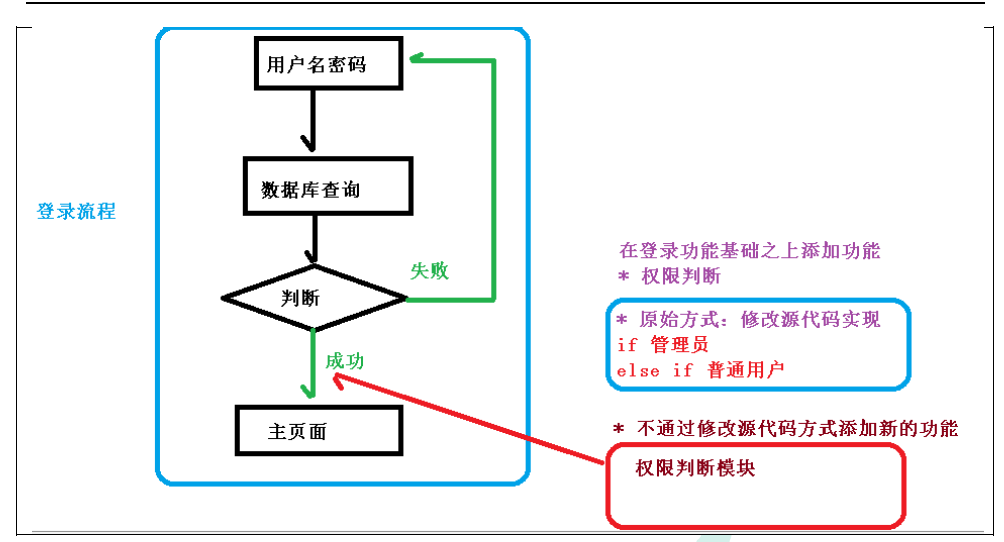
2、AOP(底层原理)
-
有两种情况动态代理
-
第一种 有接口情况,使用JDK动态代理
-
创建接口实现类代理对象,增强类的方法

-
-
第二种 没有接口情况,使用CGLIB动态代理
-
创建子类的代理对象,增强类的方法

-
-
3、AOP(JDK动态代理)
-
使用JDK动态代理,使用proxy类里面的方法创建代理对象
Java.lang.reflect
Class Proxy
java.lang.Object
Java.lang.reflect.Proxy
-
调用newProxyInstance方法
1 2
static Object newProxyInstance(ClassLoader loader,类<?> interfaces, InvocationHandle h) 返回指定接口的代理类实例,该接口将方法调用分派给指定的调用处理程序
方法有三个参数:
- 第一个参数,类加载器
- 第二个参数,增强方法所在的类,这个类实现的接口,支持多个接口
- 第三个参数,实现这个接口InvocationHandle,创建代理对象,写增强的部分
-
-
编写JDK动态代理代码
-
创建接口,定义方法
1 2 3 4 5 6
package top.withlevi.spring5.dao; public interface HelloDao { public int add(int a, int b); public String update(String id); }
-
创建接口实现类,实现方法
1 2 3 4 5 6 7 8 9 10 11 12 13 14 15
package top.withlevi.spring5.dao; public class HelloDaoImple implements HelloDao{ @Override public int add(int a, int b) { System.out.println("add method execute..."); return a + b; } @Override public String update(String id) { System.out.println("update method execute...."); return id; } }
-
使用Proxy类创建接口代理对象
1 2 3 4 5 6 7 8 9 10 11 12 13 14 15 16 17 18 19 20 21 22 23 24 25 26 27 28 29 30 31 32 33 34 35 36 37 38 39 40 41 42 43 44 45 46 47 48 49 50 51 52 53
package top.withlevi.spring5.dao; import java.lang.reflect.InvocationHandler; import java.lang.reflect.Method; import java.lang.reflect.Proxy; import java.util.Arrays; /** * Created by Levi Zhao on 3/31/2022 4:07 PM * * @Author Levi */ public class JDKProxy { public static void main(String[] args) { Class[] interfaces = {HelloDao.class}; HelloDaoImple helloDaoImple = new HelloDaoImple(); HelloDao dao = (HelloDao)Proxy.newProxyInstance(JDKProxy.class.getClassLoader(), interfaces, new UserDaoProxy(helloDaoImple)); String hello_word = dao.update("Hello Word"); System.out.println(hello_word); //int result = dao.add(3, 5); //System.out.println("result: "+result); } } class UserDaoProxy implements InvocationHandler { private Object obj; public UserDaoProxy(Object obj) { this.obj = obj; } @Override public Object invoke(Object proxy, Method method, Object[] args) throws Throwable { // execute before System.out.println("before executing method..." + method.getName() + " :Send args..." + Arrays.toString(args)); if (method.getName().equals("add")) { System.out.println("Strengthen add method"); }else if (method.getName().equals("update")){ System.out.println("Strengthen update method"); } // Strengthening method Object res = method.invoke(obj, args); // method execute after System.out.println("After executing method"); return res; } }
-
4、AOP(术语)
-
连接点
类里面哪些方法可以被增强,这些方法称为连接点
-
切入点
实际被真正增强的方法,称为切入点
-
通知(增强)
- 实际增强的逻辑不发称为通知(增强)
- 通知有多种类型
- 前置通知
- 后置通知
- 环绕通知
- 异常通知
- 最终通知
-
切面
是动作
- 把通知应用到切入点过程
5、AOP操作(准备工作)
-
spring框架一般都是基于AspectJ实现AOP操作
-
AspectJ不是Spring组成部分,独立AOP框架,一般把AspectJ和Spring框架一起使用,进行
AOP操作
-
-
基于AspectJ实现AOP操作
- 基于xml配置文件实现
- 基于注解方式实现(实用)
-
在项目工程里面引入AOP相关依赖
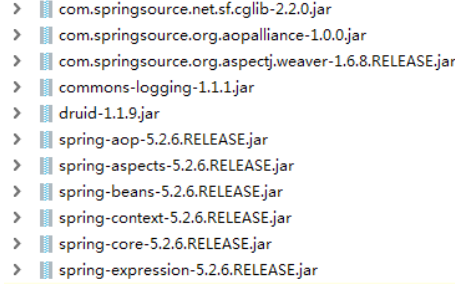
-
切入点表达式
- 切入点表达式作用: 知道对哪个类里面的哪个方法进行增强
- 语法结构: execution([权限修饰符] [返回类型] [类全路径] [方法名称] [参数列表])
举例1:对top.withlevi.bean.User类里面的ad进行增强
1
execution(* top.withlevi.bean.User.add(..))
举例2:对top.withlevi.bean类里面的所有的方法进行增强
1
execution(* top.withlevi.bean.User.*(..))
举例3:对top.withlevi.bean包里面所有类,类里面所有方法进行增强
1
execution(* top.withlevi.bean.User.*.*(..))
5、AOP操作(AspectJ注解)
5.1、创建类,在类里面定义方法
1
2
3
4
5
6
7
8
9
10
11
package top.withlevi.bean;
import org.springframework.stereotype.Component;
@Component
public class User {
public void add(){
System.out.println("add........");
}
}
5.2、创建增强类(编写增强逻辑)
1
2
3
4
5
6
7
8
9
10
11
12
13
14
15
16
17
18
19
20
21
22
23
24
25
26
27
28
29
30
31
32
33
34
35
36
37
38
39
40
41
42
43
44
45
46
47
48
49
50
51
52
53
54
55
56
57
// 在增强类里面,创建方法,让不同方法代表不同通知类型
package top.withlevi.proxy;
import org.aspectj.lang.ProceedingJoinPoint;
import org.aspectj.lang.annotation.*;
import org.springframework.stereotype.Component;
/**
* @author Levi.Zhao
* @version 1.0
* @date 2022/4/2 10:25 AM
*/
@Component
@Aspect // Generating proxy objects
public class UserProxy {
@Pointcut(value = "execution(* top.withlevi.bean.User.add(..))")
public void pointCut(){
}
// @Before Notification of annotation mark predecessors
@Before(value = "pointCut()")
public void before() { //Pre notic
System.out.println("before........");
}
// @AfterReturning Annotated logo post notification
@AfterReturning("execution(* top.withlevi.bean.User.add(..))")
public void afterReturning() {
System.out.println("afterReturning.......");
}
// @After annotated of final notification
@After(value = "execution(* top.withlevi.bean.User.add(..))")
public void after() {
System.out.println("after.....");
}
// @AfterThrowing Exception notication
@AfterThrowing(value = "execution(* top.withlevi.bean.User.add(..))")
public void afterThrowing() {
System.out.println("afterThrowing......");
}
@Around(value = "execution(* top.withlevi.bean.User.add(..))")
public void around(ProceedingJoinPoint proceedingJoinPoint) throws Throwable {
System.out.println("Around before.....");
proceedingJoinPoint.proceed();
System.out.println("Around after......");
}
}
5.3、进行通知的配置
-
在spring配置文件中,开启注解扫描
1 2 3 4 5 6 7 8 9 10 11 12 13 14 15 16 17 18
<?xml version="1.0" encoding="UTF-8"?> <beans xmlns="http://www.springframework.org/schema/beans" xmlns:xsi="http://www.w3.org/2001/XMLSchema-instance" xmlns:context="http://www.springframework.org/schema/context" xmlns:aop="http://www.springframework.org/schema/aop" xsi:schemaLocation="http://www.springframework.org/schema/beans http://www.springframework.org/schema/beans/spring-beans.xsd http://www.springframework.org/schema/context https://www.springframework.org/schema/context/spring-context.xsd http://www.springframework.org/schema/aop https://www.springframework.org/schema/aop/spring-aop.xsd"> <!--Enable auto scan--> <context:component-scan base-package="top.withlevi"/> <!--Auto aspectj generate proxy object--> <aop:aspectj-autoproxy/> </beans>
-
使用注解创建User和UserProxy对象
1 2 3 4 5
// 被增强的类 @Component Public class User{ }
```java // 增强类 @Component public class UserProxy{
}
1
2
3
4
5
6
7
8
9
10
11
3. 在增强类上面添加注解@Aspect
```java
@Component
@Aspect // 生成代理对象
public class UserProxy{
}
-
在spring配置文件中开启生成代理对象
1 2 3
<!--Auto aspectj generate proxy object--> <aop:aspectj-autoproxy/>
5.4、配置不同类型的通知
- 在增强类的里面,在作为通知方法上面添加通知类型注解,使用切入点表达式配置
1
2
3
4
5
6
7
8
9
10
11
12
13
14
15
16
17
18
19
20
21
22
23
24
25
26
27
28
29
30
31
32
33
34
35
36
37
38
39
40
41
42
43
44
45
46
47
48
49
50
package top.withlevi.proxy;
import org.aspectj.lang.ProceedingJoinPoint;
import org.aspectj.lang.annotation.*;
import org.springframework.stereotype.Component;
@Component
@Aspect // Generating proxy objects
public class UserProxy {
@Pointcut(value = "execution(* top.withlevi.bean.User.add(..))")
public void pointCut(){
}
// @Before Notification of annotation mark predecessors
@Before(value = "pointCut()")
public void before() { //Pre notic
System.out.println("before........");
}
// @AfterReturning Annotated logo post notification
@AfterReturning("execution(* top.withlevi.bean.User.add(..))")
public void afterReturning() {
System.out.println("afterReturning.......");
}
// @After annotated of final notification
@After(value = "execution(* top.withlevi.bean.User.add(..))")
public void after() {
System.out.println("after.....");
}
// @AfterThrowing Exception notication
@AfterThrowing(value = "execution(* top.withlevi.bean.User.add(..))")
public void afterThrowing() {
System.out.println("afterThrowing......");
}
@Around(value = "execution(* top.withlevi.bean.User.add(..))")
public void around(ProceedingJoinPoint proceedingJoinPoint) throws Throwable {
System.out.println("Around before.....");
proceedingJoinPoint.proceed();
System.out.println("Around after......");
}
}
5.5、相同的切入点抽取
1
2
3
4
5
// 相同切入点抽取
@Pointcut(value = "execution(* top.withlevi.bean.User.add(..))")
public void pointCut(){
}
1
2
3
4
5
// @Before Notification of annotation mark predecessors
@Before(value = "pointCut()")
public void before() { //Pre notic
System.out.println("before........");
}
5.6、有多个增强类同一个方法进行增强,设置增强类优先级
- 在增强类上面添加注解@Order(数字型值),数字类型值越小优先级越高
1
2
3
4
5
6
7
8
9
10
11
12
13
14
15
16
17
18
19
20
21
22
23
24
package top.withlevi.proxy;
import org.aspectj.lang.annotation.Aspect;
import org.aspectj.lang.annotation.Before;
import org.aspectj.lang.annotation.Pointcut;
import org.springframework.core.annotation.Order;
import org.springframework.stereotype.Component;
@Component
@Aspect
@Order(1)
public class PersonProxy {
@Pointcut(value = "execution(* top.withlevi.bean.User.add(..))")
public void pointCut(){
}
@Before(value = "pointCut()")
public void before(){
System.out.println("PersonProxy----before");
}
}
5.7、完全使用注解开发
- 创建配置类,不需要创建xml配置文件
1
2
3
4
5
6
7
8
9
10
11
12
package top.withlevi.proxy;
import org.springframework.context.annotation.ComponentScan;
import org.springframework.context.annotation.Configuration;
import org.springframework.context.annotation.EnableAspectJAutoProxy;
@Configuration
@ComponentScan(basePackages = {"top.withlevi"})
@EnableAspectJAutoProxy(proxyTargetClass = true)
public class MyConfig {
}
6、AOP操作(AspectJ配置文件)
-
创建两个类,增强类和被增强类,创建方法
1 2 3 4 5 6 7 8 9 10
package top.withlevi.bean; import com.sun.scenario.effect.impl.sw.java.JSWBlend_SRC_OUTPeer; import org.springframework.stereotype.Component; public class Book { public void buy(){ System.out.println("buy book"); } }
1 2 3 4 5 6 7 8 9 10 11
package top.withlevi.proxy; import org.aspectj.lang.annotation.Aspect; import org.aspectj.lang.annotation.Before; import org.springframework.stereotype.Component; public class BookProxy { public void before(){ System.out.println("BookProxy....."); } }
-
在spring配置文件中创建两个类对象
1 2 3 4 5 6 7 8 9 10 11 12 13 14 15 16 17 18 19 20 21
<?xml version="1.0" encoding="UTF-8"?> <beans xmlns="http://www.springframework.org/schema/beans" xmlns:xsi="http://www.w3.org/2001/XMLSchema-instance" xmlns:aop="http://www.springframework.org/schema/aop" xsi:schemaLocation="http://www.springframework.org/schema/beans http://www.springframework.org/schema/beans/spring-beans.xsd http://www.springframework.org/schema/aop https://www.springframework.org/schema/aop/spring-aop.xsd"> <!--Create bean object--> <bean id="book" class="top.withlevi.bean.Book"></bean> <bean id="bookProxy" class="top.withlevi.proxy.BookProxy"/> <aop:config> <aop:pointcut id="p" expression="execution(* top.withlevi.bean.Book.buy(..))"/> <aop:aspect ref="bookProxy"> <aop:before method="before" pointcut-ref="p"/> </aop:aspect> </aop:config> </beans>
-
在spring配置文件中配置切入点
1 2 3 4 5 6 7 8 9 10 11 12 13 14 15 16 17 18 19 20
<?xml version="1.0" encoding="UTF-8"?> <beans xmlns="http://www.springframework.org/schema/beans" xmlns:xsi="http://www.w3.org/2001/XMLSchema-instance" xmlns:aop="http://www.springframework.org/schema/aop" xsi:schemaLocation="http://www.springframework.org/schema/beans http://www.springframework.org/schema/beans/spring-beans.xsd http://www.springframework.org/schema/aop https://www.springframework.org/schema/aop/spring-aop.xsd"> <!--Create bean object--> <bean id="book" class="top.withlevi.bean.Book"></bean> <bean id="bookProxy" class="top.withlevi.proxy.BookProxy"/> <aop:config> <aop:pointcut id="p" expression="execution(* top.withlevi.bean.Book.buy(..))"/> <aop:aspect ref="bookProxy"> <aop:before method="before" pointcut-ref="p"/> </aop:aspect> </aop:config> </beans>
六、JdbcTemplate(概念和准备)
1、什么是JdbcTemplate
- Spring框架对JDBC进行封装,使用JdbcTemplate
2、准备工作和配置运行
-
引入相关jar包
Druid-1.1.9.jar
mysql-connector-java-5.1.7-bin.jar
spring-jdbc-5.3.15.jar
spring-orm-5.3.15.jar
spring-tx-5.3.15.jar
-
在外部创建jdbc.properties
1 2 3 4
prop.driverClassName=com.mysql.jdbc.Driver prop.url=jdbc:mysql://localhost:3306/levi prop.username=root prop.password=root123456
-
在spring配置文件配置相关数据
1 2 3 4 5 6 7 8 9 10 11 12 13 14 15 16 17 18 19 20 21 22 23 24 25
<?xml version="1.0" encoding="UTF-8"?> <beans xmlns="http://www.springframework.org/schema/beans" xmlns:xsi="http://www.w3.org/2001/XMLSchema-instance" xmlns:context="http://www.springframework.org/schema/context" xsi:schemaLocation="http://www.springframework.org/schema/beans http://www.springframework.org/schema/beans/spring-beans.xsd http://www.springframework.org/schema/context https://www.springframework.org/schema/context/spring-context.xsd"> <--组件扫描--> <context:component-scan base-package="top.withlevi"/> <--数据库连接池--> <context:property-placeholder location="classpath:jdbc.properties"/> <bean id="dataSource" class="com.alibaba.druid.pool.DruidDataSource" destroy-method="close"> <property name="driverClassName" value="${prop.driverClassName}"/> <property name="url" value="${prop.url}"/> <property name="username" value="${prop.username}"/> <property name="password" value="${prop.password}"/> </bean> <--配置JdbcTemplate对象,注入DataSource--> <bean id="jdbcTemplate" class="org.springframework.jdbc.core.JdbcTemplate"> <property name="dataSource" ref="dataSource"/> </bean> </beans>
-
创建dao类、创建service类、创建daoimple类
1 2 3 4 5 6 7 8 9 10 11 12 13 14 15 16 17 18 19 20 21 22 23 24 25 26 27 28 29 30 31 32 33 34 35 36 37 38 39 40 41 42 43 44 45 46 47 48 49 50 51 52 53 54 55 56 57 58 59 60 61 62 63 64 65 66 67 68 69 70
package top.withlevi.dao; import top.withlevi.bean.Order; import java.util.List; /** * @author Levi.Zhao * @version 1.0 * @date 2022/4/2 9:20 PM */ public interface OrderDao { /** * Add Order * @param order */ public void addOrder(Order order); /** * Update Order * @param order */ public void updeteOrder(Order order); /** * Delete Order * @param id */ public void deleteOrder(String id); /** * Count All Order Sum * @return */ public int countOrder(); /** * Query Order * @param id * @return */ public Order queryOrder(String id); /** * Query all orders * @return */ public List<Order> queryAllOrder(); /** * Batch Add Orders * @param batchArgs */ public void batchAddOrder(List<Object[]> batchArgs); /** * Batch Update Orders * @param batchArgs */ public void batchUpdateOrder(List<Object[]> batchArgs); /** * Batch Delete Orders * @param batchArgs */ public void batchDeleteOrder(List<Object[]> batchArgs); }
daoimple类
```java package top.withlevi.dao;
import org.springframework.beans.factory.annotation.Autowired; import org.springframework.jdbc.core.BeanPropertyRowMapper; import org.springframework.jdbc.core.JdbcTemplate; import org.springframework.stereotype.Repository; import top.withlevi.bean.Order;
import java.util.Arrays; import java.util.List;
/**
- @author Levi.Zhao
- @version 1.0
- @date 2022/4/2 9:22 PM */
@Repository public class OrderDaoImple implements OrderDao{
1
2
3
4
5
6
7
8
9
10
11
12
13
14
15
16
17
18
19
20
21
22
23
24
25
26
27
28
29
30
31
32
33
34
35
36
37
38
39
40
41
42
43
44
45
46
47
48
49
50
51
52
53
54
55
56
57
58
59
60
61
62
63
64
65
66
67
68
69
70
71
72
73
74
75
76
77
78
79
80
81
82
83
@Autowired
private JdbcTemplate jdbcTemplate;
@Override
public void addOrder(Order order) {
String sql = "insert into t_order values(?,?,?)";
Object[] args = {order.getOrderId(),order.getOrderName(),order.getOrderPrice()};
int update = jdbcTemplate.update(sql, args);
if (update>0){
System.out.println("insert successful....");
}
System.out.println(update);
}
@Override
public void updeteOrder(Order order) {
String sql = "update t_order set ordername = ?, orderprice=? where orderid=?";
Object[] args = {order.getOrderName(),order.getOrderPrice(),order.getOrderId()};
int update = jdbcTemplate.update(sql, args);
if (update>0){
System.out.println("update successful.");
}
System.out.println(update);
}
@Override
public void deleteOrder(String id) {
String sql = "delete from t_order where orderid=?";
int update = jdbcTemplate.update(sql, id);
if (update>0){
System.out.println("Delete order successful");
}
System.out.println(update);
}
@Override
public int countOrder() {
String sql = "select count(*) from t_order";
Integer count = jdbcTemplate.queryForObject(sql, Integer.class);
return count;
}
@Override
public Order queryOrder(String id) {
String sql = "select * from t_order where orderid=?";
Order order = jdbcTemplate.queryForObject(sql, new BeanPropertyRowMapper<Order>(Order.class),id);
return order;
}
@Override
public List<Order> queryAllOrder() {
String sql = "select * from t_order";
List<Order> queryAll = jdbcTemplate.query(sql, new BeanPropertyRowMapper<Order>(Order.class));
return queryAll;
}
@Override
public void batchAddOrder(List<Object[]> batchArgs) {
String sql = "insert into t_order values(?,?,?)";
int[] ints = jdbcTemplate.batchUpdate(sql, batchArgs);
System.out.println(Arrays.toString(ints));
}
@Override
public void batchUpdateOrder(List<Object[]> batchArgs) {
String sql = "update t_order set ordername=?,orderprice=? where orderid=?";
int[] ints = jdbcTemplate.batchUpdate(sql, batchArgs);
System.out.println(Arrays.toString(ints));
}
@Override
public void batchDeleteOrder(List<Object[]> batchArgs) {
String sql = "delete from t_order where orderid=?";
int[] ints = jdbcTemplate.batchUpdate(sql, batchArgs);
System.out.println(Arrays.toString(ints));
}
}
1
2
3
4
5
6
7
8
9
10
11
12
13
14
15
16
17
18
19
20
21
22
23
24
25
26
27
28
29
30
31
32
33
34
35
36
37
38
39
40
41
42
43
44
45
46
47
48
49
50
51
52
53
54
55
56
57
58
59
60
61
62
63
64
65
创建service类
```java
package top.withlevi.service;
import org.springframework.beans.factory.annotation.Autowired;
import org.springframework.stereotype.Service;
import top.withlevi.bean.Order;
import top.withlevi.dao.OrderDao;
import java.util.List;
/**
* @author Levi.Zhao
* @version 1.0
* @date 2022/4/2 9:27 PM
*/
@Service
public class OrderService {
@Autowired
private OrderDao orderDao;
public void addOrder(Order order){
orderDao.addOrder(order);
}
public void updateOrder(Order order){
orderDao.updeteOrder(order);
}
public void deleteOrder(String id){
orderDao.deleteOrder(id);
}
public int countOrder(){
return orderDao.countOrder();
}
public Order queryOrder(String id){
return orderDao.queryOrder(id);
}
public List<Order> queryAllOrder(){
return orderDao.queryAllOrder();
}
public void batchAddOrder(List<Object[]> batchArgs){
orderDao.batchAddOrder(batchArgs);
}
public void batchUpdateOrder(List<Object[]> batchArgs){
orderDao.batchUpdateOrder(batchArgs);
}
public void batchDeleteOrder(List<Object[]> batchArgs){
orderDao.batchDeleteOrder(batchArgs);
}
}
-
JdbcTemplate操作数据库(添加)
1 2 3 4 5 6 7 8 9 10 11 12 13 14 15 16 17 18 19 20 21 22 23 24 25 26 27 28 29 30 31 32 33 34 35 36 37 38 39 40 41 42 43 44 45 46 47 48 49 50 51 52 53 54 55
package top.withlevi.bean; /** * @author Levi.Zhao * @version 1.0 * @date 2022/4/2 8:30 PM */ public class Order { private String orderId; private String orderName; private double orderPrice; public Order() { } public Order(String orderId, String orderName, double orderPrice) { this.orderId = orderId; this.orderName = orderName; this.orderPrice = orderPrice; } public String getOrderId() { return orderId; } public void setOrderId(String orderId) { this.orderId = orderId; } public String getOrderName() { return orderName; } public void setOrderName(String orderName) { this.orderName = orderName; } public double getOrderPrice() { return orderPrice; } public void setOrderPrice(double orderPrice) { this.orderPrice = orderPrice; } @Override public String toString() { return "Order{" + "orderId='" + orderId + '\'' + ", orderName='" + orderName + '\'' + ", orderPrice='" + orderPrice + '\'' + '}'; } }
-
编写测试类
1 2 3 4 5 6 7 8 9 10 11 12 13 14 15 16 17 18 19 20 21 22 23 24 25 26 27 28 29 30 31 32 33 34 35 36 37 38 39 40 41 42 43 44 45 46 47 48 49 50 51 52 53 54 55 56 57 58 59 60 61 62 63 64 65 66 67 68 69 70 71 72 73 74 75 76 77 78 79 80 81 82 83 84 85 86 87 88 89 90 91 92 93 94 95 96 97 98 99 100 101 102 103 104 105 106 107 108 109 110 111 112 113 114 115 116 117 118 119 120 121 122 123
package top.withlevi.test; import org.junit.Test; import org.springframework.context.support.ClassPathXmlApplicationContext; import top.withlevi.bean.Order; import top.withlevi.service.OrderService; import java.util.ArrayList; import java.util.List; /** * @author Levi.Zhao * @version 1.0 * @date 2022/4/2 9:30 PM */ public class OrderTest { @Test public void testAdd(){ ClassPathXmlApplicationContext context = new ClassPathXmlApplicationContext("bean03.xml"); OrderService orderService = context.getBean("orderService", OrderService.class); orderService.addOrder(new Order("7","HomePod",799)); } @Test public void testUpdate(){ ClassPathXmlApplicationContext context = new ClassPathXmlApplicationContext("bean03.xml"); OrderService orderService = context.getBean("orderService", OrderService.class); orderService.updateOrder(new Order("3","iPhone13",5999)); } @Test public void testDelete(){ ClassPathXmlApplicationContext context = new ClassPathXmlApplicationContext("bean03.xml"); OrderService orderService = context.getBean("orderService", OrderService.class); orderService.deleteOrder("7"); } @Test public void testCount(){ ClassPathXmlApplicationContext context = new ClassPathXmlApplicationContext("bean03.xml"); OrderService orderService = context.getBean("orderService", OrderService.class); int i = orderService.countOrder(); System.out.println("Total order: "+i); } @Test public void testQuery(){ ClassPathXmlApplicationContext context = new ClassPathXmlApplicationContext("bean03.xml"); OrderService orderService = context.getBean("orderService", OrderService.class); Order order = orderService.queryOrder("2"); System.out.println(order); } @Test public void testQueryAllOrder(){ ClassPathXmlApplicationContext context = new ClassPathXmlApplicationContext("bean03.xml"); OrderService orderService = context.getBean("orderService", OrderService.class); List<Order> orders = orderService.queryAllOrder(); System.out.println(orders); } @Test public void testBatchAddOrder() { ClassPathXmlApplicationContext context = new ClassPathXmlApplicationContext("bean03.xml"); OrderService orderService = context.getBean("orderService", OrderService.class); List<Object[]> batchArgs = new ArrayList<>(); Object[] o1 = {"1","iPhone 13 Pro","8599"}; Object[] o4 = {"4","HomePod","799"}; Object[] o8 = {"7","iPhone 13 Pro Max","12999"}; batchArgs.add(o1); batchArgs.add(o4); batchArgs.add(o8); orderService.batchAddOrder(batchArgs); } @Test public void testBatchUpdateOrder() { ClassPathXmlApplicationContext context = new ClassPathXmlApplicationContext("bean03.xml"); OrderService orderService = context.getBean("orderService", OrderService.class); List<Object[]> batchArgs = new ArrayList<>(); Object[] o1 = {"iPhone 13 Pro","8499","1"}; Object[] o4 = {"HomePod","699","4",}; Object[] o8 = {"iPhone 13 Pro Max","13899","7"}; batchArgs.add(o1); batchArgs.add(o4); batchArgs.add(o8); orderService.batchUpdateOrder(batchArgs); } @Test public void testBatchDeleteOrder() { ClassPathXmlApplicationContext context = new ClassPathXmlApplicationContext("bean03.xml"); OrderService orderService = context.getBean("orderService", OrderService.class); List<Object[]> batchArgs = new ArrayList<>(); Object[] o1 = {"1"}; Object[] o4 = {"4",}; Object[] o8 = {"7"}; batchArgs.add(o1); batchArgs.add(o4); batchArgs.add(o8); orderService.batchDeleteOrder(batchArgs); } }
七、事务操作(事务概念)
1、什么是事务
- 事务是数据库操作最基本单元,逻辑上一组操作,要么成功,如果有一个失败所有操作都失败
- 典型场景: 银行转账
- lucy转账100元给mary
- lucy账户少100,mary多100
2、事务四个特效(ACID)
- 原子性
- 一致性
- 隔离性
- 持久性
3、事务操作(搭建事务操作环境)
Dao层
数据库操作不写业务
创建两个方法
- 少钱的方法
- 多钱的方法
Service层
业务操作
创建转账的方法
- 调用dao两个的方法
3.1、创建数据库,添加记录
mysql> select * from t_transaction;
+----+----------+-------+
| id | username | money |
+----+----------+-------+
| 1 | lucy | 1000 |
| 2 | mary | 1000 |
+----+----------+-------+
2 rows in set (0.00 sec)
3.2、创建Dao和Service,完成对象创建和注入关系
TransactionDao.java
1
2
3
4
5
6
7
8
9
package top.withlevi.dao;
public interface TransactionDao {
public void reduceMoney();
public void addMoney();
}
TransactionDaoImple.java
1
2
3
4
5
6
7
8
9
10
11
12
13
14
15
16
17
18
19
20
21
22
23
24
25
26
27
28
package top.withlevi.dao;
import org.springframework.beans.factory.annotation.Autowired;
import org.springframework.jdbc.core.JdbcTemplate;
import org.springframework.stereotype.Repository;
@Repository
public class TransactionDaoImpl implements TransactionDao {
@Autowired
private JdbcTemplate jdbcTemplate;
@Override
public void reduceMoney() {
String sql = "update t_transaction set money=money -? where username=?";
jdbcTemplate.update(sql,100,"lucy");
}
@Override
public void addMoney() {
String sql = "update t_transaction set money=money+? where username=?";
jdbcTemplate.update(sql,100,"marry");
}
}
TransactionService.java
1
2
3
4
5
6
7
8
9
10
11
12
13
14
15
16
17
18
19
20
21
22
23
24
25
26
27
28
29
// service注入dao,在dao注入Jdbctemplate 在JdcbTemplate注入DataSource
package top.withlevi.service;
import org.springframework.beans.factory.annotation.Autowired;
import org.springframework.stereotype.Service;
import org.springframework.transaction.annotation.Isolation;
import org.springframework.transaction.annotation.Propagation;
import org.springframework.transaction.annotation.Transactional;
import top.withlevi.dao.TransactionDao;
@Service
@Transactional(propagation = Propagation.REQUIRED,isolation = Isolation.REPEATABLE_READ)
public class TransactionService {
// 注入Dao
@Autowired
private TransactionDao transactionDao;
public void accountMoney(){
transactionDao.reduceMoney();
//int i = 10/0;
transactionDao.addMoney();
}
}
4、事务的操作(Spring事务管理介绍)
-
事务添加到JavaEE三层结构里面Service层(业务逻辑层)
-
在spring进行事务管理操作
- 有两种方式: 编程式事务管理和声明式事务管理(使用)
-
声明式事务管理
- 基于注解方式(使用)
- 基于xml配置文件方式
-
在spring进行声明式事务管理,底层使用AOP原理
-
spring事务管理API
-
提供一个接口,代表事务管理器,这个接口针对不同的框架提供不同的实现类
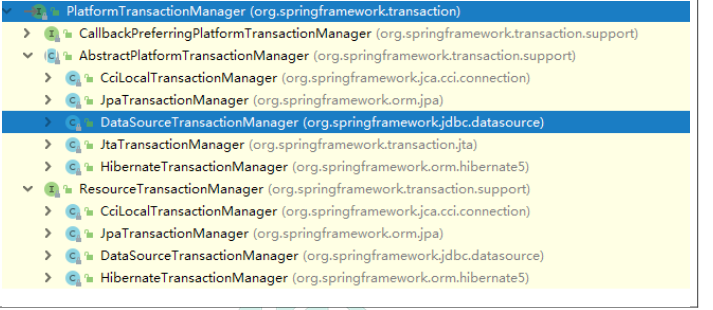
-
5、事务操作(注解声明式事务操作)
-
在spring配置文件配置事务管理器
1 2 3 4 5 6 7 8 9 10 11 12 13 14 15 16 17 18 19 20 21 22 23 24 25 26 27 28 29 30 31 32 33 34 35 36 37 38
<?xml version="1.0" encoding="UTF-8"?> <beans xmlns="http://www.springframework.org/schema/beans" xmlns:xsi="http://www.w3.org/2001/XMLSchema-instance" xmlns:context="http://www.springframework.org/schema/context" xmlns:tx="http://www.springframework.org/schema/tx" xsi:schemaLocation="http://www.springframework.org/schema/beans http://www.springframework.org/schema/beans/spring-beans.xsd http://www.springframework.org/schema/context https://www.springframework.org/schema/context/spring-context.xsd http://www.springframework.org/schema/tx http://www.springframework.org/schema/tx/spring-tx.xsd"> <--扫描组件--> <context:component-scan base-package="top.withlevi"/> <--引入外部数据库配置文件--> <context:property-placeholder location="classpath:jdbc.properties"/> <--创建数据库连接池--> <bean id="dataSource" class="com.alibaba.druid.pool.DruidDataSource" destroy-method="close"> <property name="driverClassName" value="${prop.driverClassName}"/> <property name="url" value="${prop.url}"/> <property name="username" value="${prop.username}"/> <property name="password" value="${prop.password}"/> </bean> <bean id="jdbcTemplate" class="org.springframework.jdbc.core.JdbcTemplate"> <property name="dataSource" ref="dataSource"/> </bean> <!--创建事务管理器--> <bean id="transactionManager" class="org.springframework.jdbc.datasource.DataSourceTransactionManager"> <!--注入数据源--> <property name="dataSource" ref="dataSource"/> </bean> <!--开启事务注解--> <tx:annotation-driven transaction-manager="transactionManager"></tx:annotation-driven> </beans>
-
jdbc.properties
1 2 3 4
prop.driverClassName=com.mysql.jdbc.Driver prop.url=jdbc:mysql://localhost:3306/levi prop.username=root prop.password=root123456
-
在service类上面(或者service类里面方法上面)添加事务注解
- @Transactional,这个注解添加到类上面,也可以添加方法上面
- 如果把这个注解添加类上面,这个类里面所有的方法都添加事务
- 如果把这个注解添加方法上面,为这个方法添加事务
1 2 3 4 5
@Service @Transactional public class Transaction{ }
6、事务操作(声明式事务管理参数配置)
-
在service类上面添加@Transactional,在这个注解里面可以配置事务相关参数
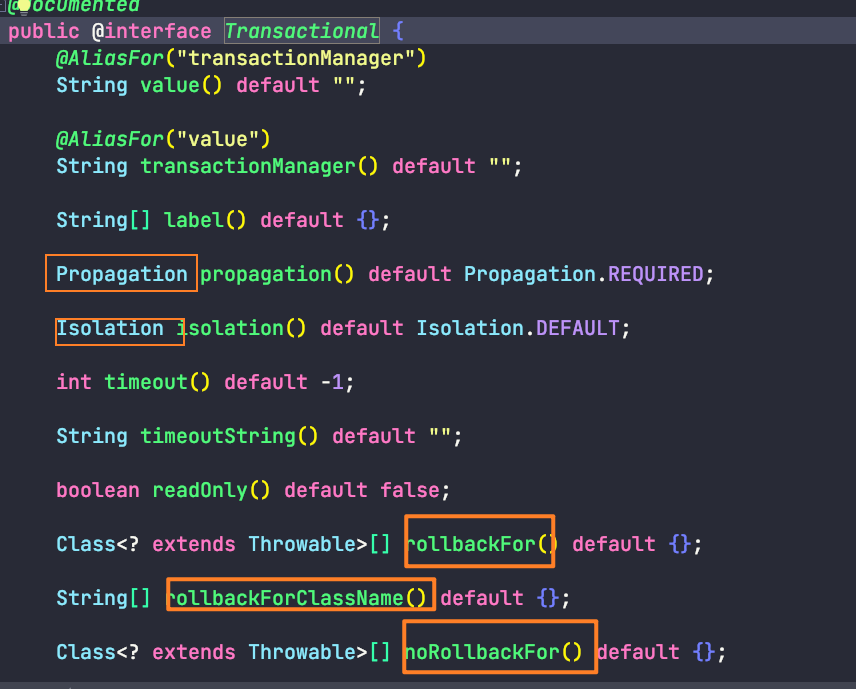
-
propagation:事务传播行为
-
多事务方法直接进行调用,这个过程中事务是如何进行管理的
事务传播行为:以下Spring定义了7中传播行为。
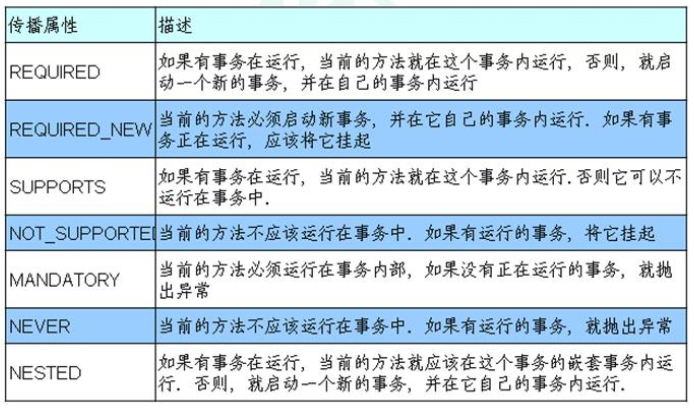
1 2 3 4 5
@Service @Transactional(propagation = Propagation.REQUIRED) public class Transaction(){ }
-
-
Ioslation: 事务隔离级别
-
事务有特性成为隔离性,多事务操作之间不会产生影响。不考虑隔离性产生很多问题
-
有三个读问题:脏读,不可重复读,虚(幻)读
-
脏读:一个未提交事务读取到另一个未提交事务的数据
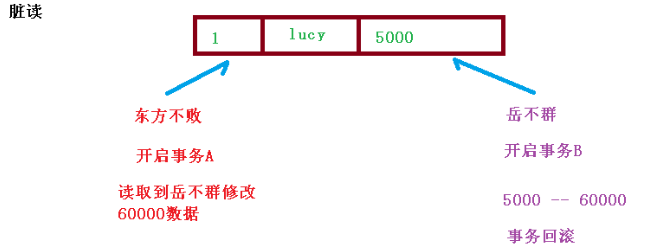
-
不可重复读:一个未提交事务读取到另一个事务修改数据
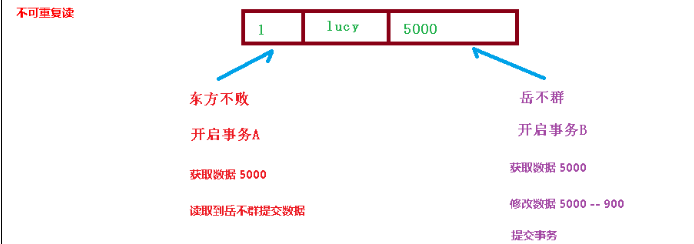
-
虚读: 一个未提交事务读取到另一提交事务添加数据
-
解决:通过设置事务隔离级别,解决读问题

1 2 3 4 5 6 7 8 9 10 11 12 13 14 15 16 17
@Service @Transactional(propagation = Propagation.REQUIRED,isolation = Isolation.REPEATABLE_READ) public class TransactionService { @Autowired private TransactionDao transactionDao; public void accountMoney(){ transactionDao.reduceMoney(); //int i = 10/0; transactionDao.addMoney(); } }
-
-
timeout: 超时时间
- 事务需要在一定时间内进行提交,如果不提交进行回滚
- 默认值是-1,设置时间以秒单位进行计算
-
readOnly:是否只读
- 读:查询操作,写: 添加修改删除操作
- readOnly默认值:false, 表示可以查询,可以添加修改删除操作
- 设置readOnly值是true,设置true之后,只能查询
-
rollbackFor: 回滚
- 设置出现哪些异常进行事务回滚
-
noRollbackFor:不回滚
- 设置出现哪些异常不进事务回滚
7、事务操作(XML声明式事务管理)
-
在spring配置文件中进行配置
- 第一步 配置事务管理器
- 第二步 配置通知
- 第三步 配置切入点和切面
1 2 3 4 5 6 7 8 9 10 11 12 13 14 15 16 17 18 19 20 21 22 23 24 25 26 27 28 29 30 31 32 33 34 35 36 37 38 39 40 41 42 43 44 45 46 47 48 49 50 51 52 53 54
<?xml version="1.0" encoding="UTF-8"?> <beans xmlns="http://www.springframework.org/schema/beans" xmlns:xsi="http://www.w3.org/2001/XMLSchema-instance" xmlns:context="http://www.springframework.org/schema/context" xmlns:tx="http://www.springframework.org/schema/tx" xmlns:aop="http://www.springframework.org/schema/aop" xsi:schemaLocation="http://www.springframework.org/schema/beans http://www.springframework.org/schema/beans/spring-beans.xsd http://www.springframework.org/schema/context https://www.springframework.org/schema/context/spring-context.xsd http://www.springframework.org/schema/tx http://www.springframework.org/schema/tx/spring-tx.xsd http://www.springframework.org/schema/aop https://www.springframework.org/schema/aop/spring-aop.xsd"> <context:component-scan base-package="top.withlevi"/> <!--引入外部数据库配置文件--> <context:property-placeholder location="classpath:jdbc.properties"/> <!--数据库连接池--> <bean id="dataSource" class="com.alibaba.druid.pool.DruidDataSource" destroy-method="close"> <property name="driverClassName" value="${prop.driverClassName}"/> <property name="url" value="${prop.url}"/> <property name="username" value="${prop.username}"/> <property name="password" value="${prop.password}"/> </bean> <!--JdbcTemplate对象--> <bean id="jdbcTemplate" class="org.springframework.jdbc.core.JdbcTemplate"> <property name="dataSource" ref="dataSource"/> </bean> <!--注入dataSource--> <bean id="transactionManager" class="org.springframework.jdbc.datasource.DataSourceTransactionManager"> <!--注入数据源--> <property name="dataSource" ref="dataSource"/> </bean> <!--配置通知--> <tx:advice id="txadvice"> <!--配置事务参数--> <tx:attributes> <!--指定哪种规则的方法上面添加事务--> <tx:method name="accountMoney" propagation="REQUIRED"/> <!-- <tx:method name="account*"/>--> </tx:attributes> </tx:advice> <!--配置切入点和切面--> <aop:config> <!--配置切入点--> <aop:pointcut id="pt" expression=" execution(* top.withlevi.service.TransactionService.*(..))"/> <!--配置切面--> <aop:advisor advice-ref="txadvice" pointcut-ref="pt"/> </aop:config> </beans>
TransactionService.java
```java package top.withlevi.service;
import org.springframework.beans.factory.annotation.Autowired; import org.springframework.stereotype.Service; import org.springframework.transaction.annotation.Isolation; import org.springframework.transaction.annotation.Propagation; import org.springframework.transaction.annotation.Transactional; import top.withlevi.dao.TransactionDao;
@Service // 如果使用xml声明式事务管理就需要把 Transactional注释掉 //@Transactional(propagation = Propagation.REQUIRED,isolation = Isolation.REPEATABLE_READ) public class TransactionService {
1
2
3
4
5
6
7
8
9
10
@Autowired
private TransactionDao transactionDao;
public void accountMoney(){
transactionDao.reduceMoney();
//int i = 10/0;
transactionDao.addMoney();
}
}
1
2
3
4
5
6
7
8
9
10
11
12
13
14
15
16
17
18
19
20
21
22
23
24
25
26
27
28
29
30
31
32
33
34
35
36
37
38
39
40
41
42
43
44
45
46
47
48
49
50
51
52
53
54
55
56
57
58
59
60
61
62
8、事务操作(完全注解声明式事务管理)
```java
package top.withlevi.config;
import com.alibaba.druid.pool.DruidDataSource;
import org.springframework.context.annotation.Bean;
import org.springframework.context.annotation.ComponentScan;
import org.springframework.context.annotation.Configuration;
import org.springframework.jdbc.core.JdbcTemplate;
import org.springframework.jdbc.datasource.DataSourceTransactionManager;
import org.springframework.transaction.annotation.EnableTransactionManagement;
import javax.sql.DataSource;
/**
* @author Levi.Zhao
* @version 1.0
* @date 2022/4/5 11:17 AM
*/
@Configuration // 配置类
@ComponentScan(basePackages = "top.withlevi") // 组件扫描
@EnableTransactionManagement // 开启事务
public class TxConfig {
// Create connect database pool
@Bean
public DruidDataSource getDruidDataSource(){
DruidDataSource dataSource = new DruidDataSource();
dataSource.setDriverClassName("com.mysql.jdbc.Driver");
dataSource.setUrl("jdbc:mysql:///levi");
dataSource.setUsername("root");
dataSource.setPassword("root123456");
return dataSource;
}
// Create JdbcTemplate Object
@Bean
public JdbcTemplate getJdbcTemplate(DataSource dataSource){
// Find dataSource in IOC container by type
JdbcTemplate jdbcTemplate = new JdbcTemplate();
jdbcTemplate.setDataSource(dataSource);
return jdbcTemplate;
}
// Create transactional
@Bean
public DataSourceTransactionManager getDataSourceTransactionManager(DataSource dataSource){
DataSourceTransactionManager transactionManager = new DataSourceTransactionManager();
transactionManager.setDataSource(dataSource);
return transactionManager;
}
}
八、spring5框架新功能
-
整个spring5框架的代码基于Java8,运行时兼容JDK9,许多不建议使用的类和方法在代码库中删除
-
Spring5.0框架自带了通用的日志封装
- spring5已经移出Log4JConfigListener,官方建议使用Log4j2
- spring5框架整合Log4j2
第一步引入jar包

第二步 创建log4j2.xml配置文件
1 2 3 4 5 6 7 8 9 10 11 12 13 14 15 16 17 18 19 20
<?xml version="1.0" encoding="UTF-8"?> <!--日志级别以及优先级排序: OFF > FATAL > ERROR > WARN > INFO > DEBUG > TRACE > ALL --> <!--Configuration后面的status用于设置log4j2自身内部的信息输出,可以不设置,当设置成trace时,可以看到log4j2内部各种详细输出--> <configuration status="INFO"> <!--先定义所有的appender--> <appenders> <!--输出日志信息到控制台--> <console name="Console" target="SYSTEM_OUT"> <!--控制日志输出的格式--> <PatternLayout pattern="%d{yyyy-MM-dd HH:mm:ss.SSS} [%t] %-5level %logger{36} - %msg%n"/> </console> </appenders> <!--然后定义logger,只有定义了logger并引入的appender,appender才会生效--> <!--root:用于指定项目的根日志,如果没有单独指定Logger,则会使用root作为默认的日志输出--> <loggers> <root level="info"> <appender-ref ref="Console"/> </root> </loggers> </configuration>
-
spring5框架核心容器支持@Nullable注解
-
@Nullable注解可以使用在方法上面,属性上面,参数上面,表示方法返回可以为空,属性值可以为空
参数值可以为空。
-
注解用在方法上面,方法返回值可以为空
1 2
@Nullable String getId();
- 注解使用在属性上面,属性值可以为空
1 2
@Nullable private String bookName;
-
-
spring5核心容器支持函数式风格GenericApplicationContext
1 2 3 4 5 6 7 8 9 10 11 12 13
// 函数式风格创建对象,交给spring进行管理 @Test public void test04(){ // 创建GenericApplicationContext对象 GenericApplicationContext context = new GenericApplicationContext(); // 调用context的方法对象注册 context.refresh(); context.registerBean("user", User.class,()->new User()); // 获取在spring注册的对象 User user = (User)context.getBean("user"); user.add(); System.out.println(user); }
-
spring5支持整合JUnit5
- 整合JUnit4
第一步引入spring相关针对测试依赖

第二步创建测试类,使用注解方式完成
1 2 3 4 5 6 7 8 9 10 11 12 13 14 15 16 17 18 19 20 21 22 23
package top.withlevi.testcode; import org.junit.Test; import org.junit.runner.RunWith; import org.springframework.beans.factory.annotation.Autowired; import org.springframework.test.context.ContextConfiguration; import org.springframework.test.context.junit4.SpringJUnit4ClassRunner; import top.withlevi.service.TransactionService; @RunWith(SpringJUnit4ClassRunner.class) @ContextConfiguration("classpath:bean01.xml") public class JTest4 { @Autowired private TransactionService transactionService; @Test public void test01(){ transactionService.accountMoney(); } }
-
spring5整合Junit5
-
第一步 引入Junit5的jar包
import org.junit.jupiter.api.Test;
-
第二步 创建测试类
1 2 3 4 5 6 7 8 9 10 11 12 13 14 15 16 17 18 19 20 21 22 23 24
package top.withlevi.testcode; import org.junit.jupiter.api.Test; import org.junit.jupiter.api.extension.ExtendWith; import org.springframework.beans.factory.annotation.Autowired; import org.springframework.test.context.ContextConfiguration; import org.springframework.test.context.junit.jupiter.SpringExtension; import top.withlevi.service.TransactionService; @ExtendWith(SpringExtension.class) @ContextConfiguration("classpath:bean01.xml") public class JTest5 { @Autowired private TransactionService transactionService; @Test public void test01(){ transactionService.accountMoney(); } }
-
-
使用一个复合注解替代上面两个注解完成整合
1 2 3 4 5 6 7 8 9 10 11 12 13 14 15 16 17 18
package top.withlevi.testcode; import org.junit.jupiter.api.Test; import org.springframework.beans.factory.annotation.Autowired; import org.springframework.test.context.junit.jupiter.SpringJUnitConfig; import top.withlevi.service.TransactionService; @SpringJUnitConfig(locations = "classpath:bean01.xml") public class JTest5_1 { @Autowired private TransactionService transactionService; @Test public void test1(){ transactionService.accountMoney(); } }

